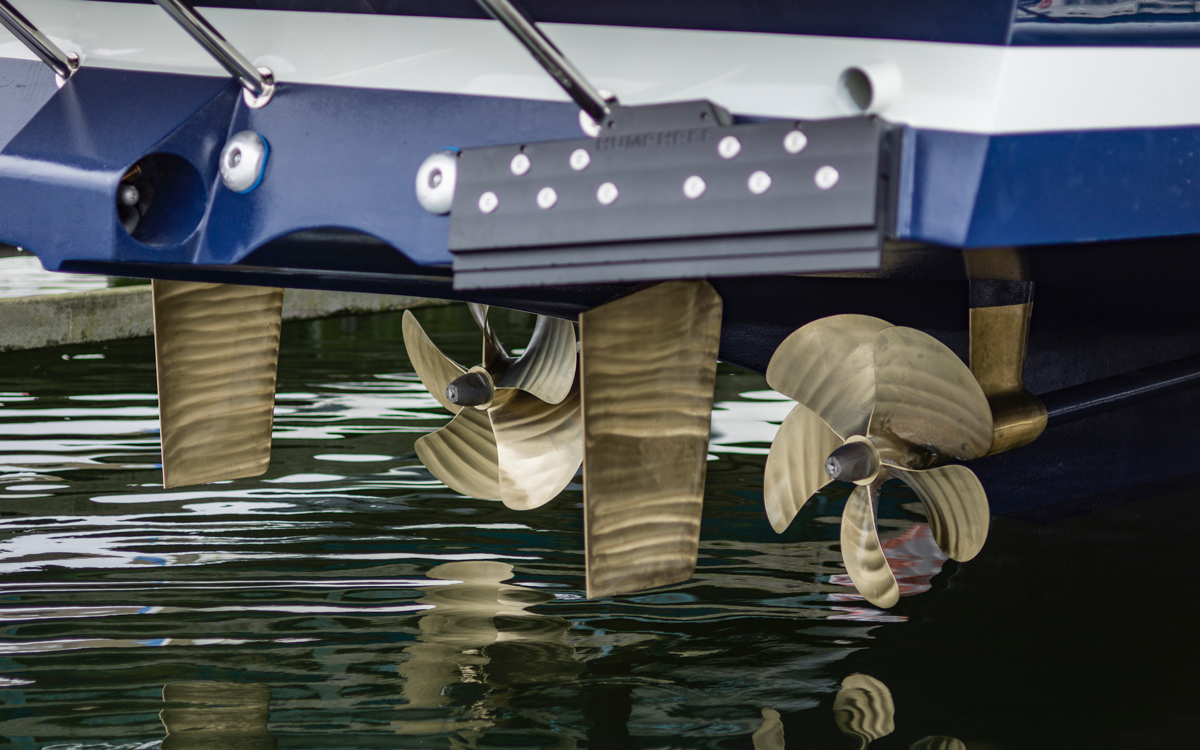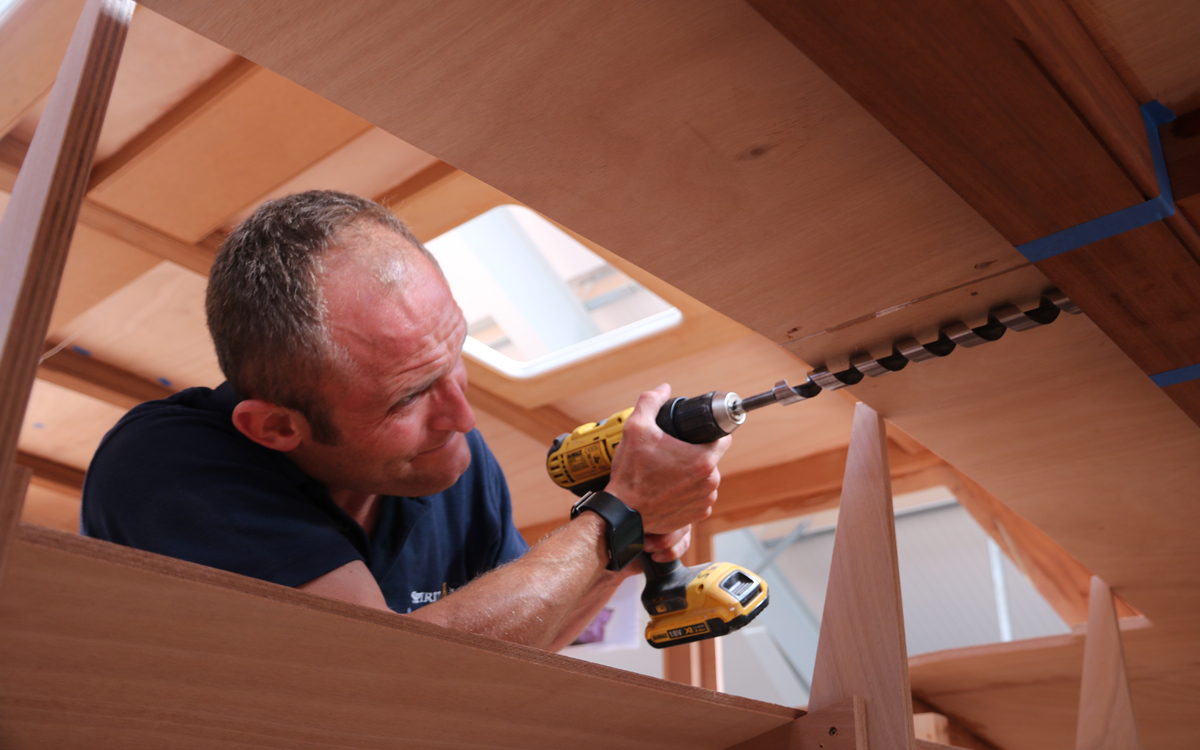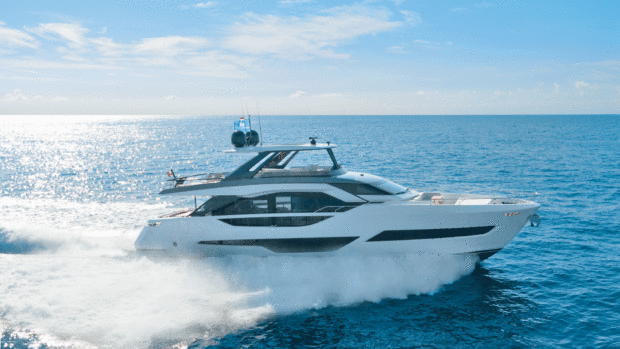Spirit Yachts may be best known for their stunning sailing boats, but in a remote corner of Ipswich docks, they have created a beautiful 21.7m motor cruiser
The P70 was recently splashed and, as these exclusive images reveal, she is every bit as stunning in real life as the renderings promised. The yard adds that her interior fit-out will now be completed ahead of the P70’s imminent sea trials.
Nigel Stuart, managing director of Spirit Yachts, said: “The launch of the P70 is a significant milestone in Spirit Yachts’ history. Whilst the core business remains sailing yachts, we are seeing increasing demand for motor yachts tailored to suit an owner’s cruising plans.
“We are responding to that demand with innovation and expertise devoted to the power range. Spirit Yachts is renowned for elegant design, build quality and engineering expertise; with the launch of the P70 the company has proven it can successfully deliver world-class motor yachts alongside its portfolio of sailing yachts.”
With regards to the design of the yacht, Spirit Yachts founder and chief designer Sean McMillan explained: “The owner will keep the P70 in the UK and cruise to the Baltic in the summer, so the yacht had to be capable of undertaking long passages in comfort but aesthetically stay true to Spirit’s timeless style and classical elegance.
“He liked the design of our existing power boats, so we combined the flared bow and tumblehome stern from the Spirit P40 with the 1930s-style of our sailing yachts and applied it to a larger motor yacht design. We added deep bulwarks to allow guests to move around the decks safely, particularly when underway out at sea.”
Article continues below…

Riva 56 Rivale: A veritable floating sculpture full of surprises
With its unique combination of art and design, of engineering and aesthetics, synonymous with the Italian shipyard Riva, the 56

Zeelander 72 review: Curvaceous gentleman’s launch gets supersized
£3350000
A challenging brief
Known only by its project name of P70, this motoryacht was commissioned by an experienced owner who was born in Norway but lives in Britain. He currently owns a semi-displacement Fleming and wants his new yacht to exceed the seakeeping, engineering and build quality the Fleming offers, but with the soul of a wooden craft built to suit his precise needs.
If this doesn’t sound like a challenging enough brief, his key requirements are that it has to be capable of cruising comfortably at 18 knots non-stop for 1,000nm through the North Sea.
That’s because although it will be based on the Hamble most of the year, he wants to be able to cruise to the Baltic for the summer months without having to worry about refuelling en route. And in case you’re wondering, he doesn’t bother with crew either; it’s usually just him and his wife or a few good mates to help with rope and fender duties.
It’s the kind of brief that would have most production yards thanking the customer politely for their enquiry before suggesting that they might like to look elsewhere. Not Spirit Yachts. Head designer and CEO Sean McMillan enjoys a challenge and the beauty of building in wood is that the usual constraints of fixed moulds don’t come into play.
Behind the scenes at Spirit Yachts
It’s not the only advantage; when used properly wood is remarkably light and strong with excellent insulation properties against sound and cold, as well as being infinitely repairable and environmentally friendly. Nor does it suffer from the leaks, rot and constant need for maintenance that wooden boats of old used to.
The trick is to use it and treat it in much the same way as the layers of gelcoat, glassfibre and foam cores that make up a conventional GRP sandwich construction.
The process starts with the creation of a set of ring frames made up from multiple layers of sapele, shaped and bonded to the exact dimensions specified by a computer program from Sean’s original hand drawings. These are fixed into position on a laser-levelled jig and planked over longitudinally with 27mm-thick strips of interlocking Douglas fir screwed and bonded to the ring frames.
Once the glue has set all the screws are removed and the holes filled to make sure there are no mechanical fixings to corrode. If this sounds worrying, bear in mind that Boeing bonds the wings of a 747 to the body of a plane for the same reason.
With the main structure now secure, between two and four layers of 3mm-thick kaya wood veneers are laid diagonally over the planking in opposite directions, marked, cut and attached using plastic staples, which are then sanded off, before being bagged and vacuum infused with epoxy resin.
Kaya looks similar to mahogany but has a more open grain, which allows it to soak up the epoxy in much the same way as woven roving glassfibre matting. Last but not least, a thin layer of transparent GRP scrim is added to create a perfectly smooth and watertight finish that can be painted or even varnished to show off the wood beneath.
The end result is a totally inert structure with much the same strength as carbon-fibre but without that material’s brittle, unforgiving nature that transmits sound and vibration almost as efficiently as a drum.
Spend a few minutes talking to Sean and you begin to wonder why more yards don’t build in wood. His answer is as telling as it is believable: building in wood requires exceptional skill and experience to achieve the necessary strength and finish expected of a high-class yacht as well as a lot of man hours. In other words, it’s neither easy nor cheap. But the best things in life rarely are.
Being a Spirit Yacht it also has to look the part. Its sailing yachts are inspired by the elegant proportions of J-Class yachts but the P70 has no obvious forebear to pick up on. It does share some of its design cues with the handful of Spirit P40s already built, such as the flared bow and tumblehome stern, but the size and volume needed to accommodate the owner’s wish for three double cabins, a covered wheelhouse, saloon and dining/galley area meant some fresh thinking was needed.
The exterior profile alone went through 22 different iterations before being signed off. The end result has a recognisable 1930s motoryacht aesthetic but with its own distinctive style and layout. The length-to-beam ratio of 4.5:1 is much slimmer and more efficient than the 3:1 ratio of most modern motoryachts, while its dry weight of 24 tonnes is almost half that of a normal 70ft GRP flybridge.
This in turn enables it to use smaller than normal 800hp MAN engines while still pushing its semi-displacement hull up to a maximum of 25 knots. Four separate fuel tanks with a combined capacity of 10,000 litres and a built-in polishing and balancing system provide the final link in the chain needed to reach the required 1,000nm range.
The layout is equally unconventional with the saloon forward and half a level down from the wheelhouse, and the dining and galley area aft another half a level down.

The owner’s cabin sits below the saloon for maximum peace and privacy, with the two twin guest cabins tucked at the opposite end of the boat in the stern. The wheelhouse itself sits proudly aloft at the centre of the action with one door out to the port sidedeck and another to the open flybridge astern with its raised outside helm position, well-protected seating for six and a 750kg-capacity crane for launching and retrieving the 3.7m RIB tender.
The only area that rivals it for sheer drama is the engineroom, which enjoys the kind of towering headroom, space and clinical lighting normally reserved for operating theatres.
Soul trader
It all speaks of an owner who knows what he wants and isn’t afraid to ask for it. It’s a relationship that Sean clearly revels in, praising the customer’s vision and technical knowledge.
For instance, he insisted on fitting Seatorque’s oil-filled BOSS shafts for quieter running and reduced maintenance, and the electrical system is built around a li-ion battery bank so that it can power the air conditioning and Sleipner curved fin stabilisers overnight without having to run the generator.
Even simple things like the deep bulwarks, which allow crew to move safely around the decks without the need for ugly stainless steel guardrails, smack of someone who has extensive experience of boating in all weathers.
Everywhere you look at Spirit Yachts, there’s a craftsman or woman using their skills and experience to create their own little work of art. This isn’t a production line, it’s a group of artisans breathing life into somebody else’s vision.
P70 specification
LOA: 21.7m (71’3″)
LWL: 20.8m (68’3″)
Beam: 5.0m (16’5″)
Draft: 1.7m laden (5’7″)
Displacement (light): 24,000kg (52,910 lbs)
Displacement (loaded): 36,000kg (79,366 lbs)
Top speed: 25 knots
Cruising speed: 18 knots
Range at 18 knots: 1,000nm
Engines: Twin 800hp MAN i6s
Fuel capacity: 10,000 litres (2,200 gal)
Water capacity: 1,200 litres (264 gal)
Stabilisers: Hydraulic Side-Power SPS55-VF650
Construction: Wood epoxy composite
Design: Sean McMillan















